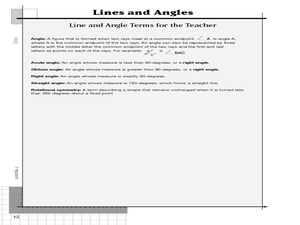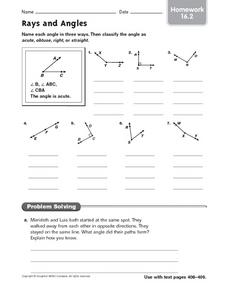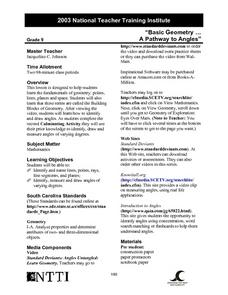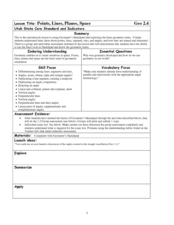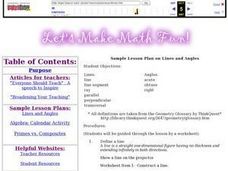Houghton Mifflin Harcourt
Lines, Line Segments, Rays, and Angles - Practice 15.1
Is it a line, line segment, ray, or angle? Identifying geometric figures is the focus. In addition to identification, learners recognize right angles or tell if an angle is less than or greater than a right angle. They tell if lines are...
Curated OER
Lines and Angles with K'NEX
Here is a geometry activitywhich invites learners to create models using their knowledge of lines, segments, rays, and angles. This activity reinforces geometric vocabulary and concepts through practical application, it also includes...
Curated OER
Rays and Angles - Homework 16.2
Learners name seven different angles in three different ways and then classify each angle as acute, obtuse, right or straight. They solve one word problem.
Curated OER
Interactivate - Lines, Rays, Line Segments, and Planes
Students explore lines, rays, line segments, and planes. In this math lesson, students discuss the math concepts and direct their instructor in graphing functions. Students collaborate in graphing additional functions.
Curated OER
Lines, Rays, and Angles
Third graders read "Pigs on the Ball" by Amy Axelrod and discuss the geometry concepts presented in the book. They use Twizzler sticks and pipe cleaners to represent lines, rays and angles.
Curated OER
Measuring Angles - Pretest Questions
Upper graders solve ten multiple choice problems about angles and measuring angles.
Curated OER
Star Wars: Rays and Angles Edition
Rays and angles and Star Wars? It sounds strange, but it's actually a fun game to help fourth graders get good at measuring and identifying angles and rays with a protractor. Each pair of children chooses which Star Wars character they'd...
Curated OER
Basic Geometry ... A Pathway to Angles
Help 9th graders identify lines, points, rays, and planes in geometry. They practice identifying, measuring, and drawing angles of different degrees. This is a fundamental lesson to help students learn the building blocks of geometry.
Willow Tree
Angle Measurement
What do you create when you rotate a ray? An angle! Teach all the angle basics including naming, measuring, supplements, and complements.
Curated OER
Points, Lines, Planes, and Space
In this points, lines, planes, and space worksheet, students solve word problems dealing with points, lines, planes, and space. Students complete 20 individual problems and 20 group problems.
Mt. San Antonio Collage
Isosceles Triangles and Special Line Segments
Under which conditions can a triangle be classified as isosceles? High schoolers practice identifying isosceles triangles and special line segments, including angle bisectors, medians of triangles, and perpendicular bisectors of sides of...
Curated OER
Study Buddies: Lines, Line Segments, and Angles
In this math worksheet, students will work with a coach to name various lines, line segments, and angels. Students will answer riddles to match pictures. Notes are provided for the coach.
Math Mammoth
Measuring Angles
The first of two pages displays various angles as the measure of degrees of a circular arc. An explanation is written, and learners are asked to model each by holding up two pencils as the rays. The second page provides instruction on...
Houghton Mifflin Harcourt
Angle Pairs - Reteach 14.2
Practice recognizing types of additive angles with a worksheet in which pupils review adjacent, interior and exterior, complementary, and supplementary angles and use a diagram to give examples of them. Be aware that the diagram involves...
EngageNY
The Inscribed Angle Alternate – A Tangent Angle
You know the Inscribed Angle Theorem and you know about tangent lines; now let's consider them together! Learners first explore angle measures when one of the rays of the angle is a tangent to a circle. They then apply their...
EngageNY
Similarity and the Angle Bisector Theorem
Identifying and verifying reproducible patterns in mathematics is an essential skill. Mathematicians identify the relationship of sides when an angle is bisected in a triangle. Once the pupils determine the relationship, they prove it to...
Curated OER
Parts of a Line
In this parts of line instructional activity, students solve and complete 12 various types of problems. First, they find the length of the indicated line segments. Then, students determine the lengths of the line segments listed.
Curated OER
Angle Exploration and Classification
Students compare and contrast angles and identify them as acute, obtuse, right, or straight angles. They create rays and angles using uncooked spaghetti, read and discuss key vocabulary terms, and complete a variety of geometry worksheets.
Curated OER
Points, Lines, Segments, Rays, and Angles
In this geometry worksheet, 5th graders label the two figures shown. Worksheet reviews and provides examples of a point, parallel lines, angles, rays, line segments, and perpendicular lines.
Curated OER
Lines and Angles
Sixth graders explore lines and angles. They create visual representations of lines, rays and angles by drawing them on paper and using a geoboard. On paper, 6th graders write a summary of the characteristics of their representations.
Curated OER
Sample Lesson Plan on Lines and Angles
Student complete worksheet using the definitions of lines and angle vocabulary. They define the word and follow a direction given on the worksheet such "construct a line." They complete an online tutorial on how to measure angles using a...
Curated OER
Mr. Bo Jangle, What's Your Angle?
Third graders explore angles. For this geometry lesson, 3rd graders identify and define acute, obtuse, and right angles. Students form angles with their bodies, find angles in picture books, and record angles found outside in their math...
K12 Reader
Kinds of Angles
Have you ever wondered how circles and angles relate to each other? Read a passage about right angles, acute angles, and obtuse angles, and answer reading comprehension questions about the information you learn.
Curated OER
Find Someone Who........
Fifth graders identify, describe, and classify lines, line segments, rays, and angles. When given a diagram of a line, they classify the line as perpendicular, parallel, intersecting, vertical, horizontal, and/or diagonal.



